INSTITUT SUPERIEUR D'ANTHROPOLOGIE
INSTITUTE OF ANTHROPOLOGY
ONLINE COURSES / COURS A DISTANCE
WINTER TERM : JANUARY 2016
REGISTER NOW
INDE - 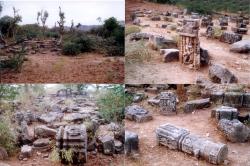 Chandravati - A team of historians and archaeologists has set off to unearth the mystery revolving Chandravati, an ancient city, which had been the capital of the Abu branch of the Parmars. Chandravati popularly known as Chandroti is today a small village situated to the south of the Abu Road station on the Ahmedabad-Delhi route located on the main highway. The third consecutive season of excavation at Chandravati near Abu Road has begun which is a joint project of JRN Rajasthan Vidyapeeth, Udaipur and department of archaeology and museums. This is the final season of excavation and archaeologists are elated at the success of the first two seasons where quite a number of interesting material, including idols, charred grain pieces, pottery etc had been discovered. "In the on going field season the team will focus on the planning of royal area, protected by double fortification, besides site catchment studies," said Prof J S Kharakwal, the project incharge. The excavation team has, in the last two field seasons discovered three forts, about half of dozen watch towers, located to the south and east of the township, remains of thirty three temples temple groups, several water structures and a large number of residential structures. The close examination of the township has revealed that the craft area is located on the southern margin of the settlement along the river Sevarni. "In the last field season as many as five different structural phases belonging to three cultural stages were identified at the site. The site has about 10m cultural deposit," Kharakwal informed. The cultural material indicate that the settlement begun around 7th century and turned into a very large settlement (about 50 hectare) around 10th-11th century when it was a capital township. A few radio carbon dates have already been obtained from Birbal Sahni Institute of Palaeobotany (BSIP) which range between 7th to 16th century AD. Presently, a team constituting K P Singh, Kul Shekhar Vyas, Narayan Paliwal, Rohit Menaria and Prakash Dangi are working on the site. "In 1024 AD, Chandravati was attacked and plundered by Mahmud Ghazni when he passed through Rajasthan to attack Anahilavada. The remained city of Chandravati was destroyed more by the vandalism at the time of building the railway track between Mawal and Abu road," said Mubarik Hussain, Superintendent of Archaeology Department.
Chandravati - A team of historians and archaeologists has set off to unearth the mystery revolving Chandravati, an ancient city, which had been the capital of the Abu branch of the Parmars. Chandravati popularly known as Chandroti is today a small village situated to the south of the Abu Road station on the Ahmedabad-Delhi route located on the main highway. The third consecutive season of excavation at Chandravati near Abu Road has begun which is a joint project of JRN Rajasthan Vidyapeeth, Udaipur and department of archaeology and museums. This is the final season of excavation and archaeologists are elated at the success of the first two seasons where quite a number of interesting material, including idols, charred grain pieces, pottery etc had been discovered. "In the on going field season the team will focus on the planning of royal area, protected by double fortification, besides site catchment studies," said Prof J S Kharakwal, the project incharge. The excavation team has, in the last two field seasons discovered three forts, about half of dozen watch towers, located to the south and east of the township, remains of thirty three temples temple groups, several water structures and a large number of residential structures. The close examination of the township has revealed that the craft area is located on the southern margin of the settlement along the river Sevarni. "In the last field season as many as five different structural phases belonging to three cultural stages were identified at the site. The site has about 10m cultural deposit," Kharakwal informed. The cultural material indicate that the settlement begun around 7th century and turned into a very large settlement (about 50 hectare) around 10th-11th century when it was a capital township. A few radio carbon dates have already been obtained from Birbal Sahni Institute of Palaeobotany (BSIP) which range between 7th to 16th century AD. Presently, a team constituting K P Singh, Kul Shekhar Vyas, Narayan Paliwal, Rohit Menaria and Prakash Dangi are working on the site. "In 1024 AD, Chandravati was attacked and plundered by Mahmud Ghazni when he passed through Rajasthan to attack Anahilavada. The remained city of Chandravati was destroyed more by the vandalism at the time of building the railway track between Mawal and Abu road," said Mubarik Hussain, Superintendent of Archaeology Department.
http://timesofindia.indiatimes.com/city/jaipur/Excavation-to-unfold-Chandravati-mystery/articleshow/50423460.cms
USA – 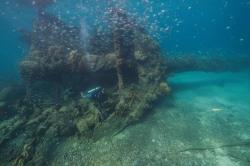 Dry Tortugas - If the ocean had highways, the intersection at the Dry Tortugas and the Florida Straits might well have ranked among the planet’s most dangerous, at least in ye olde times. Ships threading its treacherous reefs wrecked for centuries, sometimes at a rate of once a week, leaving behind an untold fortune in booty. Key West was built on a good chunk of those spoils. And modern-day treasure hunters still scour the region in search of loot. Which is why the National Park Service, guardian of a vast swath of potentially wreck-laden waters in Dry Tortugas National Park, has for the first time started surveying the deep waters within its boundaries.
Dry Tortugas - If the ocean had highways, the intersection at the Dry Tortugas and the Florida Straits might well have ranked among the planet’s most dangerous, at least in ye olde times. Ships threading its treacherous reefs wrecked for centuries, sometimes at a rate of once a week, leaving behind an untold fortune in booty. Key West was built on a good chunk of those spoils. And modern-day treasure hunters still scour the region in search of loot. Which is why the National Park Service, guardian of a vast swath of potentially wreck-laden waters in Dry Tortugas National Park, has for the first time started surveying the deep waters within its boundaries.
VIDEO http://www.miamiherald.com/news/local/environment/article52753595.html
ROYAUME UNI –  Lancashire - Amateur archaeologists have discovered several Roman roads in Britain using maps provided by the Environment Agency for assessing areas at risk of flooding. The maps were created by aircraft equipped with laser scanners and revealed ancient roads in the North and South West of England. Lidar and light detection were used by the Environment Agency to map England's landscape for decades but the data was only made freely available to the public in 2013. Two years later, the amateur archaeologists found at least seven Roman roads, including an 11-mile track between Ribchester and Lancaster. David Ratledge, who is part of the group of Roman road hunters, said: "With the help of lidar we finally discovered that they had taken a very sensible and economical route via Longridge and Inglewhite to Catterall, near Garstang. He said the road in Lancashire is the first 'new' Roman road to be discovered in 150 years. Mr Ratledge explained: "The road is remarkably clear in several sections - one stretch of prominent agger is even visible in Google Streetview.
Lancashire - Amateur archaeologists have discovered several Roman roads in Britain using maps provided by the Environment Agency for assessing areas at risk of flooding. The maps were created by aircraft equipped with laser scanners and revealed ancient roads in the North and South West of England. Lidar and light detection were used by the Environment Agency to map England's landscape for decades but the data was only made freely available to the public in 2013. Two years later, the amateur archaeologists found at least seven Roman roads, including an 11-mile track between Ribchester and Lancaster. David Ratledge, who is part of the group of Roman road hunters, said: "With the help of lidar we finally discovered that they had taken a very sensible and economical route via Longridge and Inglewhite to Catterall, near Garstang. He said the road in Lancashire is the first 'new' Roman road to be discovered in 150 years. Mr Ratledge explained: "The road is remarkably clear in several sections - one stretch of prominent agger is even visible in Google Streetview.
http://travel.aol.co.uk/2016/01/02/lost-roman-roads-discovered-flood-maps-lancashire/
ROYAUME UNI –  Edinburgh - A skeleton discovered buried under a primary school playground could be that of a 16th century pirate, archaeologists have said. The remains of a man were uncovered by council workers during survey work for an extension at Victoria Primary School in Newhaven, Edinburgh, last year. Experts at AOC Archaeology carbon dated the bones to the 16th or 17th centuries and, working with forensic artist Hayley Fisher, created a facial reconstruction of the man, thought to have been in his fifties.
Edinburgh - A skeleton discovered buried under a primary school playground could be that of a 16th century pirate, archaeologists have said. The remains of a man were uncovered by council workers during survey work for an extension at Victoria Primary School in Newhaven, Edinburgh, last year. Experts at AOC Archaeology carbon dated the bones to the 16th or 17th centuries and, working with forensic artist Hayley Fisher, created a facial reconstruction of the man, thought to have been in his fifties.
http://www.glasgowsouthandeastwoodextra.co.uk/news/scottish-headlines/16th-century-pirate-skeleton-found-under-primary-school-playground-1-3990371
TURQUIE – 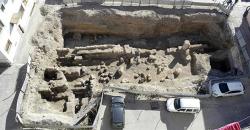 Tarsus - Works at an archaeological site in the southern province of Mersin’s historical Tarsus district have unearthed an ancient road. In a written statement, Tarsus Museum Director Mehmet Çavuş said drainage work in the field had revealed an ancient road built using the polygonal technique. Çavuş said a number of shops and terra-cotta jacking pipes were also discovered uncovered at the western section of the ancient road. “The basalt ancient road is 215 meters away from the historical Cleopatra Gate, known as the naval gate. It was one of the main arterial roads providing access to Mersin. The road has the same features as the Ancient Street, which was discovered in the center of Tarsus during excavations carried out between 1993 and 2003,” he added.
Tarsus - Works at an archaeological site in the southern province of Mersin’s historical Tarsus district have unearthed an ancient road. In a written statement, Tarsus Museum Director Mehmet Çavuş said drainage work in the field had revealed an ancient road built using the polygonal technique. Çavuş said a number of shops and terra-cotta jacking pipes were also discovered uncovered at the western section of the ancient road. “The basalt ancient road is 215 meters away from the historical Cleopatra Gate, known as the naval gate. It was one of the main arterial roads providing access to Mersin. The road has the same features as the Ancient Street, which was discovered in the center of Tarsus during excavations carried out between 1993 and 2003,” he added.
http://www.hurriyetdailynews.com/ancient-road-uncovered-in-turkeys-tarsus-.aspx?pageID=238&nid=93321
INDE –  Lingala Banda - A narrow rusty road and then a trek of more than 1.5 km on a sheer expanse of bare stone. This is how you reach the famous Shaivite shrine atop Lingala Banda, a hillock a few kilometres away from Rayadurgam town of Anantapur district, which is dubbed as a “rarest of the rare” temple by noted archaeologist Emani Siva Nagi Reddy. Four Nandis, the mythological vehicle of Lord Shiva, form an integral part of the monolithic sculpture of the presiding deity – the Lingam– here. “The Nandis here, unlike the other Shiva shrines that have the guard of the Lord a few metres away from the lingam, are looking away from it. It is a sort of experiment in the expression of Shaivism in the country,” says O. Ramasubba Reddy, Technical officer with the Archaeology and Museums Department, Anantapur. Folklore has it that the temple was built by the Chalukyas, who ruled over the modern day Karnataka and parts of Andhra Pradesh between 6th and 12th century AD. Despite the uniqueness of the temple, never has it been promoted nor preserved.
Lingala Banda - A narrow rusty road and then a trek of more than 1.5 km on a sheer expanse of bare stone. This is how you reach the famous Shaivite shrine atop Lingala Banda, a hillock a few kilometres away from Rayadurgam town of Anantapur district, which is dubbed as a “rarest of the rare” temple by noted archaeologist Emani Siva Nagi Reddy. Four Nandis, the mythological vehicle of Lord Shiva, form an integral part of the monolithic sculpture of the presiding deity – the Lingam– here. “The Nandis here, unlike the other Shiva shrines that have the guard of the Lord a few metres away from the lingam, are looking away from it. It is a sort of experiment in the expression of Shaivism in the country,” says O. Ramasubba Reddy, Technical officer with the Archaeology and Museums Department, Anantapur. Folklore has it that the temple was built by the Chalukyas, who ruled over the modern day Karnataka and parts of Andhra Pradesh between 6th and 12th century AD. Despite the uniqueness of the temple, never has it been promoted nor preserved.
http://www.thehindu.com/news/national/andhra-pradesh/rare-siva-temple-cries-for-attention/article8052634.ece
EGYPTE – 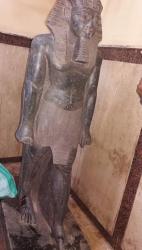
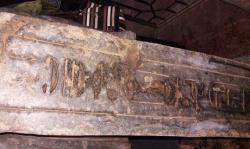 Edfou - In collaboration with Edfu police, Egypt's antiquities ministry has succeeded in recovering a black granite colossus of the 18th Dynasty King Amenhotep III. Minister of Antiquities Mamdouh Eldamaty told Ahram Online that the statue was found by chance when Edfu police entered a residential house in the Upper Egypt village of Al-Nakhl in Edfu, Aswan, to catch red-handed weapons and drugs traders. The middle part of the statue and its reverse side are engraved with hieroglyphic text while its base is decorated with the king’s various titles.
Edfou - In collaboration with Edfu police, Egypt's antiquities ministry has succeeded in recovering a black granite colossus of the 18th Dynasty King Amenhotep III. Minister of Antiquities Mamdouh Eldamaty told Ahram Online that the statue was found by chance when Edfu police entered a residential house in the Upper Egypt village of Al-Nakhl in Edfu, Aswan, to catch red-handed weapons and drugs traders. The middle part of the statue and its reverse side are engraved with hieroglyphic text while its base is decorated with the king’s various titles.
http://english.ahram.org.eg/NewsContent/9/40/178839/Heritage/Ancient-Egypt/King-Amenhotep-III-statue-accidently-recovered-in-.aspx
TURQUIE – 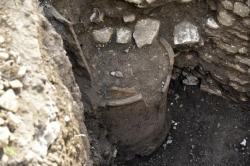 Bodrum - An ancient water well has been unearthed during a drainage excavation at a construction site in the western province of Muğla’s Bodrum district. The construction of a housing project on Alibaba Street in Bodrum’s Çarşıbaba neighborhood unearthed a number of artifacts thought to date back to the Hellenistic era. The most significant artifact unearthed was an old terracotta water well. The Bodrum Underwater Archaeology Museum took the field where the well was discovered under protection.
Bodrum - An ancient water well has been unearthed during a drainage excavation at a construction site in the western province of Muğla’s Bodrum district. The construction of a housing project on Alibaba Street in Bodrum’s Çarşıbaba neighborhood unearthed a number of artifacts thought to date back to the Hellenistic era. The most significant artifact unearthed was an old terracotta water well. The Bodrum Underwater Archaeology Museum took the field where the well was discovered under protection.
http://www.hurriyetdailynews.com/hellenistic-era-well-found-in-bodrum-.aspx?pageID=238&nid=93233